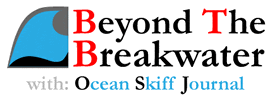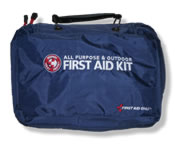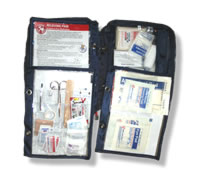Is There a Doctor in the House? Some Thoughts on First Aid…
In this post we share some thoughts on first aid situations. It is part V of our series on safety while fishing offshore from your own small boat. Previous post covered getting out and back, staying afloat, dealing with Man Overboard situations, and fishing safety.
Hopefully, everyone has a first aid kit on board, and a basic knowledge of first aid. Keep in mind that if you’re offshore, help could be hours, not minutes, away. That means you must be able to deal with certain situations for an extended period of time, compared to the same emergency on dry land.
Do you have enough of the right things? Or too much of the wrong things?
- On Toy Boat 2 we have an off-the-shelf first aid kit from First Aid Only. Billed as an “Outdoors” kit, it contains a bunch of useful things – several types of bandages, gauze and compresses, analgesics, antiseptic wipes, topical antibacterial ointment, plus some miscellaneous tools like tweezers, and scissors, and a concise first aid guide, all packaged in a nice cordura nylon binder.
- But like most off-the-shelf first aid kits, it also contains a few things we’ll probably never use, or are redundant: safety pins, plastic gloves, sunscreen, lip balm, heat packs, cold packs, a space blanket, etc. The unneeded stuff doesn’t take up much room, so we’ve elected to leave them in the kit. In times past, we’ve chosen to ditch the unneeded items and replace them with more of the supplies that are more likely to be needed, such as additional gauze and compresses.
- This is an entirely personal thing – you need to evaluate your own situation and decide what’s best for you. In this case, the First Aid Only kit probably has too many supplies for a day trip on a boat with 2-3 people, unless you’re incredibly accident-prone (I mean, how many 3″ band-aids do you really need?).
Does your first aid kit need a check-up?
- When was the last time you opened up your first aid kit to make sure everything was OK?
- Many first aid kits are not packaged in airtight, waterproof containers, and moist ocean air can cause the contents to mold and mildew over time. Our last first aid kit was kept in a cool, sheltered spot for several years without being examined. When we finally opened it to get a band-aid, almost everything was mildewed or covered with mold and literally crumbled in our hands.
- Don’t forget that medications may expire.
- So…take a peak before your next trip. It could save you a lot of pain and / or discomfort.
Do you know what to do?
- Take a basic first aid course and a CPR course
- You might need to keep someone going via CPR for some time until help can arrive. We’ve actually completed basic CPR courses three times – twice as part of SCUBA diving classes, the last from a workplace safety program.
- That same workplace safety program also covered basic first aid, so we learned how to deal with eye injuries, major lacerations and broken bones.
- The one thing we haven’t practiced is hook removal. We’ve seen one “painless” technique for removing hooks described in print, but have not tried it (this is the trick where you push down on the eye of the hook while simultaneously jerking the hook out backwards with a loop of line around the bend). These kinds of things are never practiced until it’s too late, so we’re going to try it on our next steak or rib roast (when the wife’s not looking, of course). Keep in mind that this technique would be impossible to perform on yourself, if you were hooked in the hand or arm



